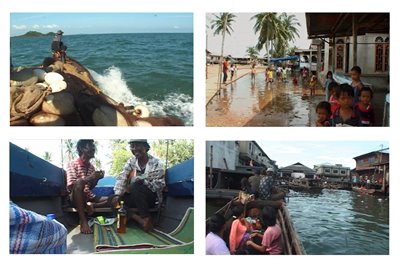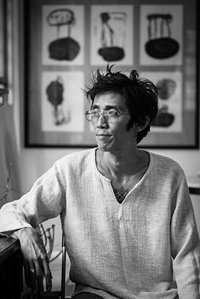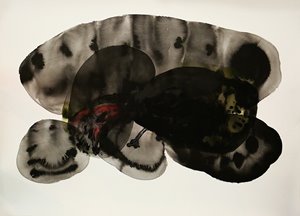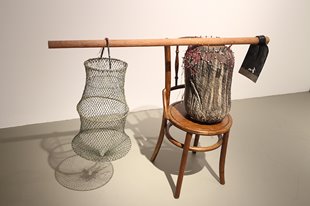 MY OPEN LETTER: On Art, Friendship and the Concept of Asia
MY OPEN LETTER: On Art, Friendship and the Concept of Asia
Words by John Mateer
This is Perth, and yet Malacca.
- Edwin Thumboo, “After the Leaving”
First: A Story
On my way back from a trip to Europe last year I managed to arrange a meeting with an acquaintance, an artist, in Singapore. Having only the evening in the island-city, and knowing that Zai is often flexible with details like time, being familiar with jam karet or elastic time, from my stay in Sumatra a few years before, I was concerned I might miss him. We arranged to rendezvous at the kopitiam opposite the Substation artspace on Armenian Street.
Eventually, Zai arrived with a beautiful casualness. He greeted friends who were sitting at a table near the front of the coffee-shop, then came to sit with me.
 After ordering our beers we fell into a deep conversation that, whenever I try to describe it, reminds me of the way the Persian mystics Shams of Tabriz and Rumi were said to have ‘connected’. In the words of the translator Coleman Barks, they were “transported to a world of pure conversation”.
After ordering our beers we fell into a deep conversation that, whenever I try to describe it, reminds me of the way the Persian mystics Shams of Tabriz and Rumi were said to have ‘connected’. In the words of the translator Coleman Barks, they were “transported to a world of pure conversation”.
We spoke about so many things – the history of Singapore, his sculptural homage to the playwright Kuo Pao Kun that I had seen on my previous visit, the mono-mania of the famous Japanese photographer Araki Nobuyoshi – but most I was impressed by Zai’s accounts of this travels. Although at that point he was a month or two away from returning to Japan, where he now lives, he told me about the year he spent with the Orang Laut, the Sea Nomads of the region around Riau in western Indonesia.
 He had intended to make a documentary about them and had bought a boat and set out to find them. These legendary people live in family groups and travel by sea, literally having no ‘homeland’. After having little success, he was on an island taking a break from his search when he told a fisherman about his hope to meet these people and make a film about them. The fisherman – in my imagination – laughed, saying, You’ll never find them. But they will come here. You must wait for them here. Zai, realizing that the man was right, and that he would never find them on the open ocean or among the thousands of islands that make up what the European explorers called The Malay Archipelago, took the man’s advice and his offer to build him a hut near the beach where the Orang Laut were expected to arrive sometime in the not too distant future.
He had intended to make a documentary about them and had bought a boat and set out to find them. These legendary people live in family groups and travel by sea, literally having no ‘homeland’. After having little success, he was on an island taking a break from his search when he told a fisherman about his hope to meet these people and make a film about them. The fisherman – in my imagination – laughed, saying, You’ll never find them. But they will come here. You must wait for them here. Zai, realizing that the man was right, and that he would never find them on the open ocean or among the thousands of islands that make up what the European explorers called The Malay Archipelago, took the man’s advice and his offer to build him a hut near the beach where the Orang Laut were expected to arrive sometime in the not too distant future.
After months of waiting, the morning after a full moon, Zai woke and found that a group of the Sea People had arrived in about twenty boats. He spent the following year traveling with them, trying to make the documentary that he envisioned in which he had intended to record the history of the Orang Laut.
It wasn’t to be. After a few months of filming he completely lost interest in the project. The sense of purposelessness had been creeping up on him. Initially, he had shot a lot of footage and had had a sense of the filmic structure of the work. Then he found himself gradually losing the sense of how the film might be shot, and he even found it hard to make a narrative of the everyday life of these people. Then, still later, he progressively lost interest in looking on and would forget to use the camera, until the very idea of making a document and the idea of history itself seemed vague and unreal, nothing like the life of the people he was among.
Zai left me that wonderfully humid evening at the bus stop where I caught a double-decker back to my hotel. But what has never left me is the feeling that I had just received a powerful lesson on the question of history, and whenever I feel an encroaching despair about culture or history or my own activities as a writer, I think of that encounter.
Friendship and the Concept of Asia
Today it is easy to feel that cultural activities, especially so-called cross-cultural activities, are about diplomacy and trade – and certainly they are – but for me as someone who loves art and literature I prefer to think of them as acts towards friendship. This is not friendship of the kind that Prime Ministers and Presidents are said to have for one another when they are on good diplomatic terms, but real friendship that is produced though vulnerability, conversation and gift-giving.
When I hear the word ‘Asia’ I have no concept for the place, no sense of it as an entity, no definite emotional response. All that comes to mind are memories of those places I have been, the bits of language I have learnt and the people I have met.
And in thinking of the people, I always think of their lives and histories radiating outward from them and from our meetings. In my mind’s eye their pasts are like a hand-made fishing net in which we – momentarily – are the fish.
When I remember those people – whether the Chinese-Indonesian translator and poet whom I came to know in Medan, Sumatra, and through whom I found out about the important contribution his forebears made to his country before its Revolution, or a Muslim South African friend who is descended from slaves and who, when I first met her, was currently researching the history of the Cape Malays, or the artist Simryn Gill who was born in the hospital on Armenian Street and who is claimed by the artworlds of Singapore, Malaysia and Australia – I remember foremost the specifics of my encounters with them or their work.
I remember the translator’s glowing face when he found out I was a poet. I remember the book my Cape Malay friend lent me, which detailed the origins of the slaves who were brought to the Cape of Good Hope. (In it I discovered that slaves whose place of capture or purchase was unknown were given Africa as their last name.) And I remember the first time I saw Simryn Gill’s work: bits of urban detritus, flattened cans and bits of metal all given wheels, as if illustrating that the Buddhist notion of impermanence applies even to junk. So to me a generality like the concept of Asia hardly enters into my consciousness.
 What these encounters, whether in person, through an artwork or by email, affirm for me is the possible of the transformation of my own sense of reality and my understanding of the world, and it necessitates intellectual and emotional openness. No real history and no art of any serious depth can be produced without the risk of this kind of openness and the vulnerability that it requires. I would never have learnt of the ancient Buddhist kingdom which was based in the Straits had I not ‘taken a chance’ by living for two months in Medan, nor would Zai have learnt the life of the Sea Nomads had he not trusted the fisherman and waited for them in his hut for the months required.
What these encounters, whether in person, through an artwork or by email, affirm for me is the possible of the transformation of my own sense of reality and my understanding of the world, and it necessitates intellectual and emotional openness. No real history and no art of any serious depth can be produced without the risk of this kind of openness and the vulnerability that it requires. I would never have learnt of the ancient Buddhist kingdom which was based in the Straits had I not ‘taken a chance’ by living for two months in Medan, nor would Zai have learnt the life of the Sea Nomads had he not trusted the fisherman and waited for them in his hut for the months required.
Now: Art and the Open Letter
In this foregrounding of the idea of friendship as the locus of meaningful exchange and personal transformation there can also be seen to be a lesson about the nature of art.
Artworks are not, in essence, objects. They are always things existing as artifacts in a network, the relationships between material, activity and meaning. Seeing artworks as acts of friendship channels the sociability of art-making in a particular direction – towards the establishment of amicable and fruitful relationships. It is possible to see this as the natural tendency of art. When I think of the installations of Montien Boonma, with their references to Buddhist practice and architecture and their use of medicinal herbs, or of the video-art of Fiona Tan, someone who is well-known in Europe but who was born in Indonesia and spent part of her life in Australia, I’m drawn to finding analogies for their works in social activities, thinking of meditation and of genealogies, what use to be the work of grandmothers, those key figures in traditional societies.
 While there has been a increasing trend to create social situations as the loci for art practice in The West – a concept I find just as difficult to locate as ‘Asia’ – my first sense of artworks, especially the works I have over the years come to respect, is that of their being the start of a conversation, either the work itself initiates the conversation by being an initial, preemptive statement requiring my response, or as a ‘conversation-starter’ which encourages those people who are engaged by the work to begin speaking with one another. Seeing art as an interpersonal encounter and interpersonal encounters as art gives a beautiful symmetry to what might otherwise become a process of instrumentalist exchange.
While there has been a increasing trend to create social situations as the loci for art practice in The West – a concept I find just as difficult to locate as ‘Asia’ – my first sense of artworks, especially the works I have over the years come to respect, is that of their being the start of a conversation, either the work itself initiates the conversation by being an initial, preemptive statement requiring my response, or as a ‘conversation-starter’ which encourages those people who are engaged by the work to begin speaking with one another. Seeing art as an interpersonal encounter and interpersonal encounters as art gives a beautiful symmetry to what might otherwise become a process of instrumentalist exchange.
The phrase cultural exchange is used so frequently in the discourse around contemporary art that we most often accept the idea that there might be something to exchange, and this objectifies art, when it might well be the case that there is little to ‘exchange’ in that, material, sense. Personally, I would prefer if we re-conceptualised these kinds of activities by renaming them, more tentatively, and somewhat awkwardly: acts in hope of friendship.
Fortunately, the curators of the exhibition this essay is to accompany like an articulate but humble friend have found a more succinct coinage and an equally optimistic concept in the open letter. The open letter, being a letter that functions in much the same way as any other, as a person-to-person private communication, is also a public declaration calling for a broad response. This open letter, like every effective contemporary artwork, is a statement of individualism and an invitation to start conversations with friends and those who might become friends.
Remembering Someone else…
A few years ago I had an encounter that, like the meeting with Zai, gave me a greater awareness of my relationship to the world. I was in a minibus in Durban, South Africa, with a number of poets, one of whom was an important Africanist, the Sudanese-born Taban lo Liyong. Taban asked me where I was from. At that point I had recently moved to Melbourne. When I told him that I had spent a decade living in Western Australia and that I had found it incredibly isolated, almost an island, he revealed that during his tenure at the University of Papua New Guinea he, too, had come to know the city. He had taken his holidays in Perth.
He agreed that it was insular. Yes, he had confided in me. Looking at the rest of Africa from South Africa is like looking at the continent from the moon. But looking at Africa from Perth, Western Australia… that must be like looking at the world from Outer Space!
I often wonder, had he lived in Australia, whether he would have said something similar of the place called Asia. And whether he might have expected to find friends there.
IMAGES (from top to bottom): John Mateer potrait. Photographer: Daniel Terkl.; Zai Kuning, RIAU, 2003, Digital Video, 16 9 ratio colour, sound, 29'45''. Image courtesy of Ota Fine Arts Singapore.; Zai Kuning, Portrait, Image courtesy of Ota Fine Arts Singapore; Zai Kuning, Ruans yang tersembunyi meyepi - Hidden space in solitary, 2016 Ink and watercolour on paper, 82,5x114,3cm. Image courtesy of Ota Fine Arts Singapore.; Zai Kuning, To be a farmer, 2014, Mixed media, 120x27xH98cm. Image courtesy of Ota Fine Arts Singapore.
This essay was commissioned for the catalogue of Open Letter, an exhibition curated by Binghui Huangfu for Asialink in 2005. It included Dadang Christanto, Emil Goh, Selina Ou, Vienna Parreno with Krzysztof Osinski, George Poonkhin Khut with John Tonkin, Melissa Ramos, Koky Saly , Phaptawan Suwannakudt and My Le Thi. It toured several countries in South-East Asia.
John Mateer is a writer and curator. His most recent project explores the continuing connections and parallels that exist between the histories and politics of Australian, South African, Dutch and Balinese contemporary art. He is the keynote speaker for the forum Art Cargo, presented by Artsource and UWA Cultural Precinct.